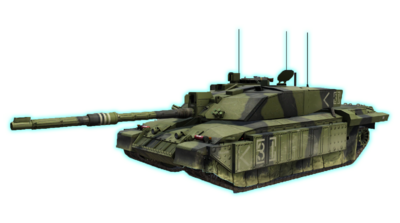The FV4034 Challenger 2 (MoD designation "CR2") is a third generation British main battle tank (MBT) in service with the armies of the United Kingdom, Oman, and Ukraine.
It was designed by Vickers Defence Systems (now BAE Systems Land & Armaments) as a private venture in 1986, and was an extensive redesign of the company's earlier Challenger 1 tank.[10] The Ministry of Defence ordered a prototype in December 1988. Despite outward similarities to the Challenger 1, design and technological developments mean that only about 3% of components are interchangeable with the earlier vehicle.
The Challenger 2 has a crew of four. The main armament is a L30A1 120-millimetre (4.7 in) rifled tank gun, an improved derivative of the L11 gun used on the Chieftain and Challenger 1.[12] Fifty rounds of ammunition are carried for the main armament, alongside 4,200 rounds of 7.62 mm ammunition for the tank's secondary weapons: a L94A1 EX-34 chain gun mounted coaxially, and a L37A2 (GPMG) machine gun. The turret and hull are protected with second generation Chobham armour, also known as Dorchester. Powered by a Perkins CV12-6A V12 diesel engine, the tank has a range of 550 kilometres (340 mi) and maximum road speed of 59 kilometres per hour (37 mph).
The Challenger 2 eventually completely replaced the Challenger 1 in British service. In June 1991, the UK ordered 140 vehicles, followed by a further 268 in 1994; these were delivered between 1994 and 2002. The tank entered operational service with the British Army in 1998 and has since been used in Bosnia and Herzegovina, Kosovo and Iraq.[8] To date, two Challenger 2 tanks have been destroyed in operations; the first was by accidental friendly fire from another Challenger 2 in Basra in 2003,[14] and the second was during the Russo-Ukrainian War, where the tank was destroyed under Ukrainian control during the 2023 Ukrainian counteroffensive.
Challenger 2 tanks were also ordered by Oman in the 1990s with delivery of 38 vehicles being completed in 2001. A number of British Challenger 2 tanks were delivered to Ukraine in 2023.
Since the Challenger 2 entered service in 1998, various upgrades have sought to improve its protection, mobility and lethality. This has culminated in an upgraded design, known as Challenger 3, which is set to gradually replace Challenger 2 from 2027.[1]
| Name | Typ | P0[A 1] in mm RHA | v0[A 2] in m/s | Reichweite in m | Herkunft | Ersteinsatz |
|---|---|---|---|---|---|---|
| L27A1 CHARM3 APFSDS | KE | 610 | 1675 | 3500 | GB | 1999 |
| L23A1 APFSDS | KE | 480 | 1542 | 3500 | GB | 1985 |
| L26A1 CHARM1 APFSDS | KE | 510 | 1575 | 3500 | GB | 1991 |
| L28A1 APFSDS | KE | 630 | 1720 | 3500 | GB | 2000s |
| L31A7 HESH-T | HESH | 370 | 670 | 4000 | GB | 1985 |
| L34 WP | WP | 180 | 670 | 4000 | GB | 1985 |
| 7,62 x 51 | MG | 11 | 854 | 1200 | NATO | |
| M61 7,62 x 51 AP | MG | 14 | 854 | 1600 | NATO | 1960s |
| Smoke | Nebel | 1 | 42 | 40 | US | |
| Multispectral Smoke | Nebel | 1 | 70 | 50 | 2000s |
Bildergallerie
- ↑ "Challenger 2". Wikipedia. Abgerufen am 13.09.2023.




